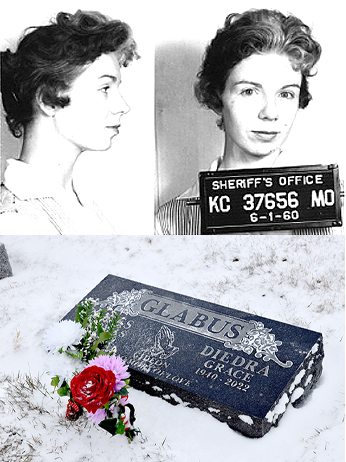Current Temperature
-6.9°C
Convicted killer and international fugitive escapes justice in Taber for decades
Posted on February 6, 2025 by Taber Times Times Photo by Meg Noguchi. WHERE SHE RESTS: Dee Glabus died in Taber in 2022. She had lived in the town since 1973.
Times Photo by Meg Noguchi. WHERE SHE RESTS: Dee Glabus died in Taber in 2022. She had lived in the town since 1973.By Cal Braid
Taber Times
Local Journalism Initiative Reporter
A Taber woman spent decades hiding in plain sight as a fugitive from American justice and her true identity has now been revealed. Sharon Kinne was accused of killing her first husband and her married lover’s wife in the U.S. in the early 1960s before she fled the states and was convicted of killing another man in a hotel room in Mexico.
Kinne was convicted of murder in Mexico and served almost five years in prison before she escaped in 1969 and vanished without a trace. In the early 1970s, Kinne showed up in Taber as Diedra (Dee) Glabus and blended seamlessly into the community, never raising any suspicions that might have tied her to a murderous past.
In mid-January, The Times received a tip that the Kinne/Glabus connection was imminent from the Jackson County Sheriff’s Office. On Jan. 24, the tipster, a retired FBI agent living in Kansas City, MO, spoke with us about his interest in the case.
On Jan. 27, the Times contacted both the Taber Police Service and the Jackson County Sheriff’s Office asking for confirmation about the veracity of the claim. TPS Chief Graham Abela replied that day and said he was not at liberty to discuss the matters.
“We may be able to speak later about these matters but as for now it is the Sheriff’s investigation in Missouri,” he said. Jackson County ignored our request but Abela’s response confirmed his knowledge of the case.
Three days later the news broke internationally, much to the shock and dismay of Taber residents, as already documented by the CBC. The timeline of murder in her first life as Sharon Kinne is a patchwork of confirmed reports from the Kansas City Star, Jackson County Sheriffs, and CBC.
In March 1960, Kinne claimed that she heard a gunshot while she was in the bathroom of her home in Independence, Mo. She told Jackson County officials that she found her husband, James Kinne, shot in the head and dead in their bedroom. She called it an accidental shooting by her two-year-old daughter.
Years later, Col. William Morton, the first officer on scene, told a Kansas City talk radio host, “She said she was in the bathroom getting ready for dinner and she heard her daughter say ‘Daddy, how’s this thing work?’ Then she heard a shot and she said she ran in the bedroom and discovered her husband. She said that the little daughter had shot him.…we bought it at that time.”
Just two months later in May 1960, a woman named Patricia Jones was reported missing by her husband, Walter Jones. Jones had tried to end his adulterous affair with Kinne after she claimed that she was pregnant. Not long after, Kinne met another former lover and took him to the place where Patricia Jones lay shot dead by four .22 caliber bullets. The ex-lover suggested reporting the discovery to the police, but Kinne refused and wanted to be taken home.
When the ex-lover reported the murder, investigators said he admitted Kinne had been present when the body was found. On May 31, 1960, Kinne was arrested for the murders of Patricia Jones and James Kinne and tried separately on the charges.
In June 1961, her trial for the Jones murder resulted in an acquittal. In Jan. 1962, her first trial for the James Kinne murder ended in conviction and a sentence of life imprisonment, but the verdict was overturned because of procedural errors. The case went to a second trial and ended quickly in a mistrial. A third trial in July 1964 ended in a 7-5 hung jury. Kinne was released on bond following the third trial and traveled to Mexico with yet another boyfriend to purportedly get married before a scheduled fourth trial could be held in October 1964.
In Mexico, Kinne met Francisco Paredes Ordoñez at a bar, and went to a hotel room with him. A hotel employee heard gunshots and went to the room, where he found Kinne with a pistol and Ordonez shot dead. Kinne shot the employee in the shoulder before he fled and called the police. Kinne claimed self-defense in warding off sexual advances from Ordoñez.
The subsequent investigation uncovered a damning similarity: Ordoñez was shot with the same weapon that killed Patricia Jones. In Oct. 1965, Kinne was convicted of the Ordoñez killing and sentenced to thirteen years in prison after a judicial review. She escaped during a blackout in Dec. 1969 and disappeared off the map until she was identified as Dee Glabus in 2025.
Reports put Kinne with James Glabus in Los Angeles in 1970, where the two married before relocating to Taber in 1973. How the two obtained Visas, identification, and citizenship is unknown, but as the newly-minted Dee Glabus, she and her husband owned and operated the Taber Motel and worked as realtors. James died in 1979 and reportedly left Dee out of his will, an omission that she fought in court.
A Southland Funeral Home obituary said that Glabus married William (Willie) Ell in 1982 and the two remained married until Ell’s death in 2011 at the age of 79.
Kinne was the subject of one of the longest outstanding warrants for murder in the Kansas City area and one of the longest outstanding felony warrants in U.S. history, the Kansas City Police Dept. said in a statement.
In Dec. 2023, Jackson County Sheriff’s Office and KCPD received an anonymous tip from an individual believed to be from Alberta. The tip led the agencies to Diedra Glabus, deceased as of Jan. 2022.
Taber Police Service Chief Graham Abela was the lead investigator on the ground in Taber as he collaborated with Sgt. Dustin Love in Jackson County. Abela said he knew Dee Glabus as a resident who was never on the TPS radar. “I knew her for many, many years. She was well known in the community,” he said, affirming that she hadn’t been suspected, accused, or convicted of any illegal activity.
Her identification was never scrutinized by law enforcement because she stayed out of trouble. When asked if she possessed a driver’s license, Abela simply said that he had seen her driving in town.
Apparently, it wasn’t only friends, neighbours, and acquaintances who were in the dark about her real identity and history of violence. Abela said to the best of his knowledge, the secret was withheld from her family. “I can tell you that during the investigation that we conducted, no one had any awareness or clue that this was even a possibility,” he said.
Without the anonymous tip and a bit of fingerprinting luck, the real story may have never emerged. But it wasn’t straightforward, and jurisdictional technicalities could have posed a problem.
“There’s a piece of legislation called the Identification of Criminals Act that allows police agencies to obtain fingerprints from deceased persons who have criminal records. And what that does is that allows the system to expunge the fingerprints of people that are passed away,” Abela said.
There was no need to do post-mortem fingerprints on Dee Glabus because TPS and the RCMP didn’t have a criminal record on her.
However, “The funeral home has a service that they provide where they obtain fingerprints from deceased people as precious mementos of someone. For their loved ones,” Abela continued. “And there’s a service that provides that as a software service program. That is how we came to know that a fingerprint actually existed. I called up the funeral home and asked the question and there was one there.”
The trouble was, TPS couldn’t obtain the print without a search warrant, and it couldn’t get a search warrant because no known offense was committed in Canada.
“As a result, we were going to have to go through a mutual legal aid treaty process in order to get that print,” the chief said.
Then he hit on a stroke of luck.
“I was able to find out through a search that the company that possessed the actual data was actually in Independence, MO, which is where the warrants were still in effect. Once I found out that the company was in the United States, and found out that it was in Missouri, literally within a few blocks of where the sheriff’s office is, the sheriff there was able to get an administrative subpoena through their legal system and actually go to the company, service that subpoena on that company, and obtain the print which they then compared.”
Because the data storage centre was in Missouri, Jackson County was able to use its legal system to legally obtain the print, “rather than go through mutual legal aid, which would have taken months and months and months,” Abela said.
He said the family has now appointed a spokesman, but the Times has yet to connect with him. While Kinne’s disappearing act has finally been solved – in Taber of all places – the head-scratching may continue for a while. The story lends itself to nagging uncertainties and legitimizes questions about who walks among us.
Leave a Reply
You must be logged in to post a comment.

